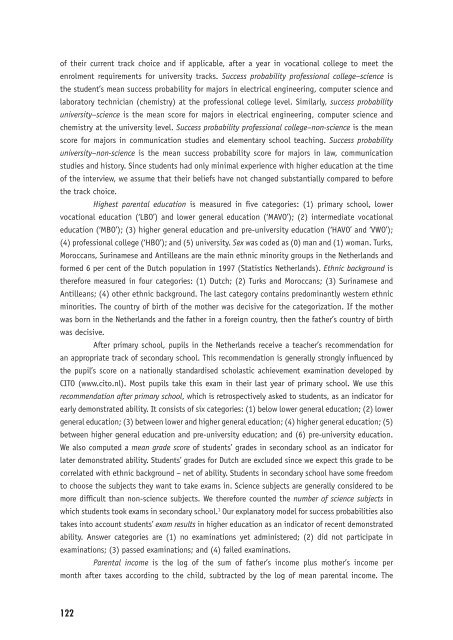Ethnic Hostility among Ethnic Majority and Minority Groups
Ethnic Hostility among Ethnic Majority and Minority Groups
Ethnic Hostility among Ethnic Majority and Minority Groups
You also want an ePaper? Increase the reach of your titles
YUMPU automatically turns print PDFs into web optimized ePapers that Google loves.
of their current track choice <strong>and</strong> if applicable, after a year in vocational college to meet the<br />
enrolment requirements for university tracks. Success probability professional college–science is<br />
the student’s mean success probability for majors in electrical engineering, computer science <strong>and</strong><br />
laboratory technician (chemistry) at the professional college level. Similarly, success probability<br />
university–science is the mean score for majors in electrical engineering, computer science <strong>and</strong><br />
chemistry at the university level. Success probability professional college–non-science is the mean<br />
score for majors in communication studies <strong>and</strong> elementary school teaching. Success probability<br />
university–non-science is the mean success probability score for majors in law, communication<br />
studies <strong>and</strong> history. Since students had only minimal experience with higher education at the time<br />
of the interview, we assume that their beliefs have not changed substantially compared to before<br />
the track choice.<br />
Highest parental education is measured in fi ve categories: (1) primary school, lower<br />
vocational education (‘LBO’) <strong>and</strong> lower general education (‘MAVO’); (2) intermediate vocational<br />
education (‘MBO’); (3) higher general education <strong>and</strong> pre-university education (‘HAVO’ <strong>and</strong> ‘VWO’);<br />
(4) professional college (‘HBO’); <strong>and</strong> (5) university. Sex was coded as (0) man <strong>and</strong> (1) woman. Turks,<br />
Moroccans, Surinamese <strong>and</strong> Antilleans are the main ethnic minority groups in the Netherl<strong>and</strong>s <strong>and</strong><br />
formed 6 per cent of the Dutch population in 1997 (Statistics Netherl<strong>and</strong>s). <strong>Ethnic</strong> background is<br />
therefore measured in four categories: (1) Dutch; (2) Turks <strong>and</strong> Moroccans; (3) Surinamese <strong>and</strong><br />
Antilleans; (4) other ethnic background. The last category contains predominantly western ethnic<br />
minorities. The country of birth of the mother was decisive for the categorization. If the mother<br />
was born in the Netherl<strong>and</strong>s <strong>and</strong> the father in a foreign country, then the father’s country of birth<br />
was decisive.<br />
After primary school, pupils in the Netherl<strong>and</strong>s receive a teacher’s recommendation for<br />
an appropriate track of secondary school. This recommendation is generally strongly infl uenced by<br />
the pupil’s score on a nationally st<strong>and</strong>ardised scholastic achievement examination developed by<br />
CITO (www.cito.nl). Most pupils take this exam in their last year of primary school. We use this<br />
recommendation after primary school, which is retrospectively asked to students, as an indicator for<br />
early demonstrated ability. It consists of six categories: (1) below lower general education; (2) lower<br />
general education; (3) between lower <strong>and</strong> higher general education; (4) higher general education; (5)<br />
between higher general education <strong>and</strong> pre-university education; <strong>and</strong> (6) pre-university education.<br />
We also computed a mean grade score of students’ grades in secondary school as an indicator for<br />
later demonstrated ability. Students’ grades for Dutch are excluded since we expect this grade to be<br />
correlated with ethnic background – net of ability. Students in secondary school have some freedom<br />
to choose the subjects they want to take exams in. Science subjects are generally considered to be<br />
more diffi cult than non-science subjects. We therefore counted the number of science subjects in<br />
which students took exams in secondary school. 1 Our explanatory model for success probabilities also<br />
takes into account students’ exam results in higher education as an indicator of recent demonstrated<br />
ability. Answer categories are (1) no examinations yet administered; (2) did not participate in<br />
examinations; (3) passed examinations; <strong>and</strong> (4) failed examinations.<br />
Parental income is the log of the sum of father’s income plus mother’s income per<br />
month after taxes according to the child, subtracted by the log of mean parental income. The<br />
122












